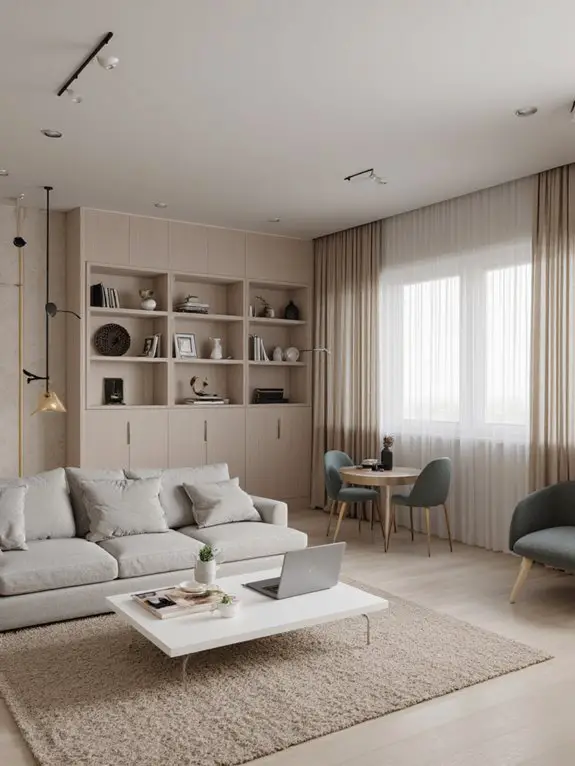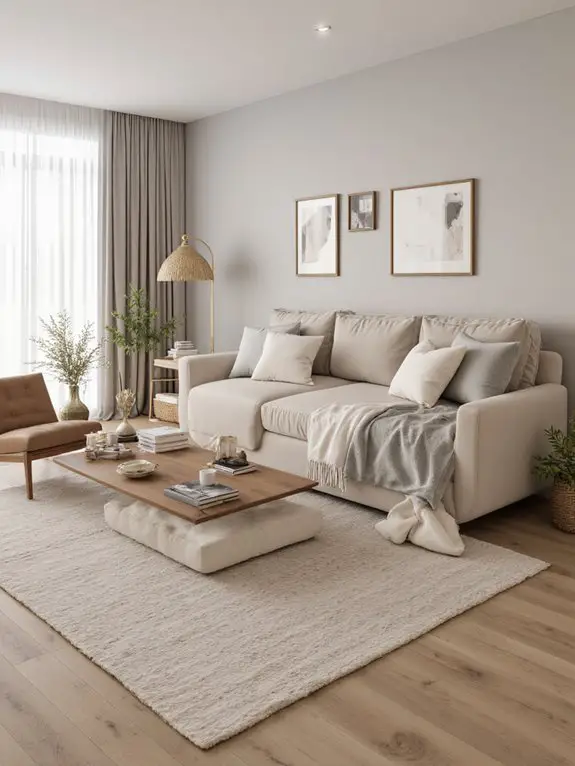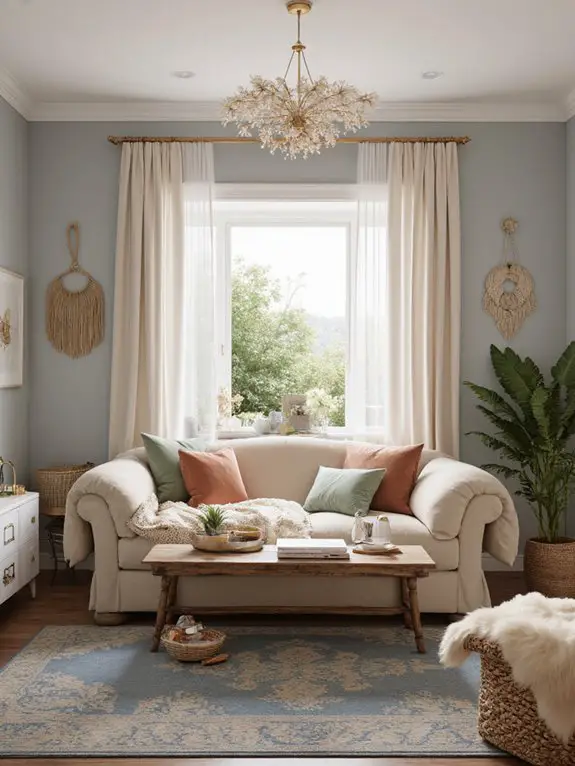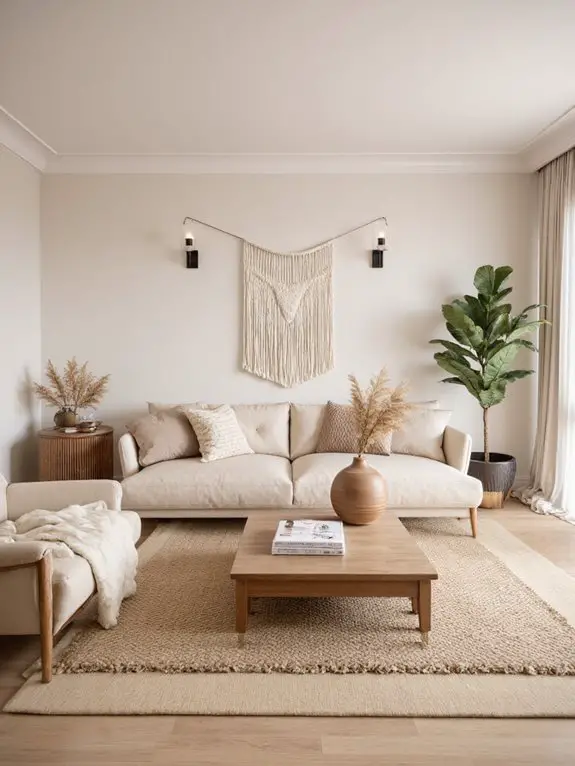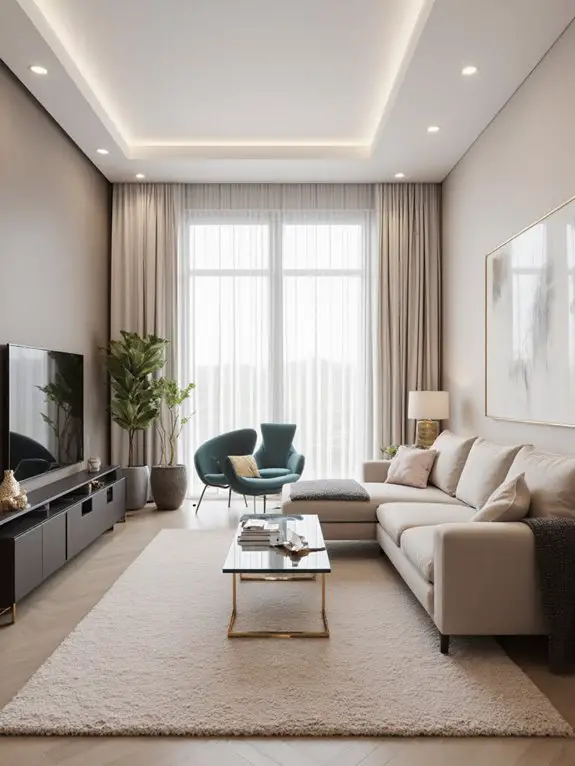I’ve found that creating a multifunctional living room requires clever furniture choices and smart storage solutions to maximize both style and practicality. Modular furniture like sectional sofas and nesting tables offers flexibility, while a sleeper sofa easily accommodates guests. Built-in storage walls and ottomans with hidden compartments keep clutter at bay. For added versatility, I recommend a foldable dining table and a vertical garden to blend greenery with functionality. Discover more ways to transform your space efficiently.
Utilize Modular Furniture for Flexibility
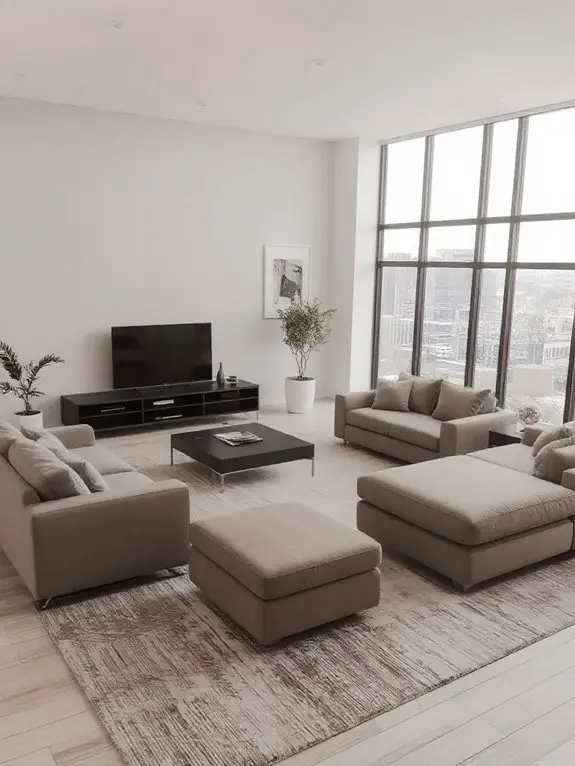
When I’m designing a multifunctional living room, I always start with modular furniture because it’s a game-changer for flexibility. Pieces like sectional sofas with detachable units, nesting coffee tables, and movable storage cubes let you reconfigure the space effortlessly.
I love how they adapt to different needs—whether hosting guests, creating a cozy reading nook, or maximizing floor play. Opt for neutral colors to maintain cohesion and multifunctionality. Lightweight materials make rearranging a breeze.
Modular furniture isn’t just practical; it’s stylish, too, blending seamlessly into modern or minimalist aesthetics. It’s the foundation for a room that evolves with your lifestyle.
Incorporate a Sleeper Sofa for Overnight Guests
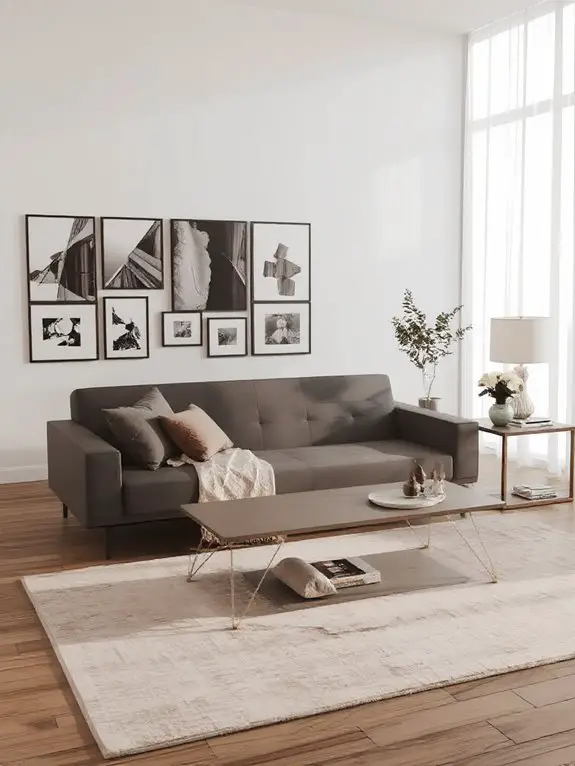
Adding a sleeper sofa is a smart way to enhance your living room’s versatility, especially if you often host overnight guests. I love how it doubles as both seating and a bed without taking up extra space. Look for one with a comfortable mattress—memory foam or innerspring—so guests sleep well.
Choose a style that matches your decor, whether modern or traditional. Some models even have storage for linens, keeping everything tidy. It’s a practical solution that saves you from needing a guest room. Just unfold it when needed, and your living room transforms into a cozy sleeping area instantly.
Design a Built-In Storage Wall
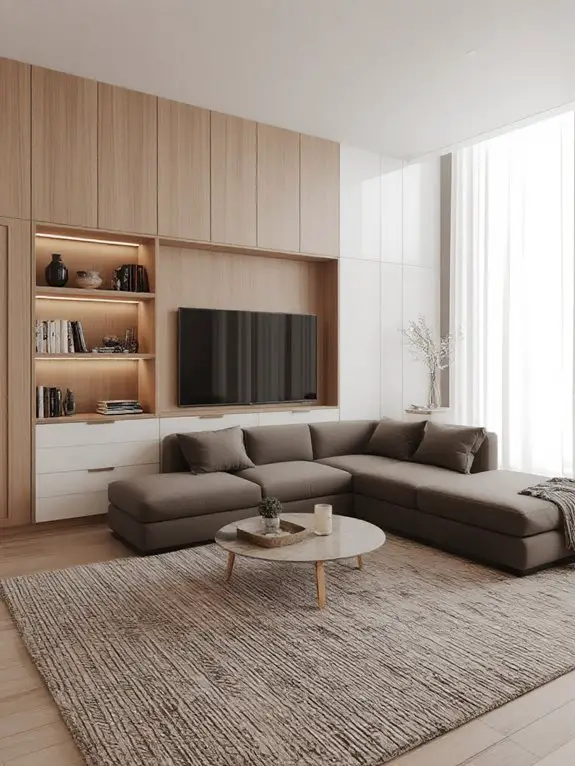
To maximize both functionality and aesthetics in a living room, a built-in storage wall can be a game-changer, seamlessly blending organization with design.
I recommend customizing it to fit your space, incorporating a mix of open shelves, cabinets, and drawers to accommodate various items.
Use materials like wood or painted MDF for a cohesive look that complements your decor. Consider adding lighting to highlight display areas and make the room feel more inviting.
Strategically place frequently used items within easy reach, while storing less-used objects behind closed doors. This approach keeps clutter at bay while enhancing the room’s overall appeal.
Create a Dual-Purpose Home Office Corner
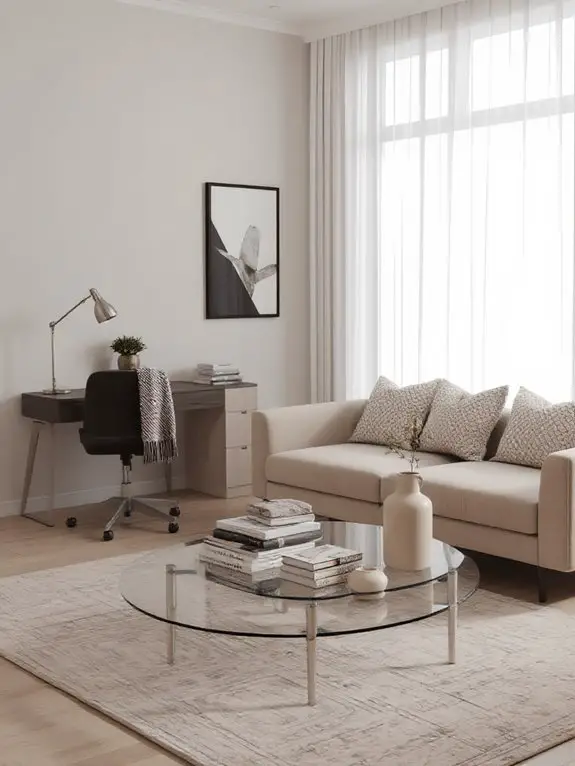
Combining workspace functionality with living room comfort, a dual-purpose home office corner can transform an underutilized area into a productive and stylish zone. I recommend choosing a compact desk that complements your decor, like a sleek floating shelf or a minimalist console.
Pair it with an ergonomic chair that blends seamlessly with your seating arrangement. Use vertical storage—shelves or wall-mounted organizers—to keep essentials within reach without cluttering the space.
A stylish desk lamp or statement plant can elevate the look while enhancing functionality. This setup guarantees I can work efficiently without sacrificing the cozy, inviting feel of my living room.
Add a Foldable Dining Table for Versatility
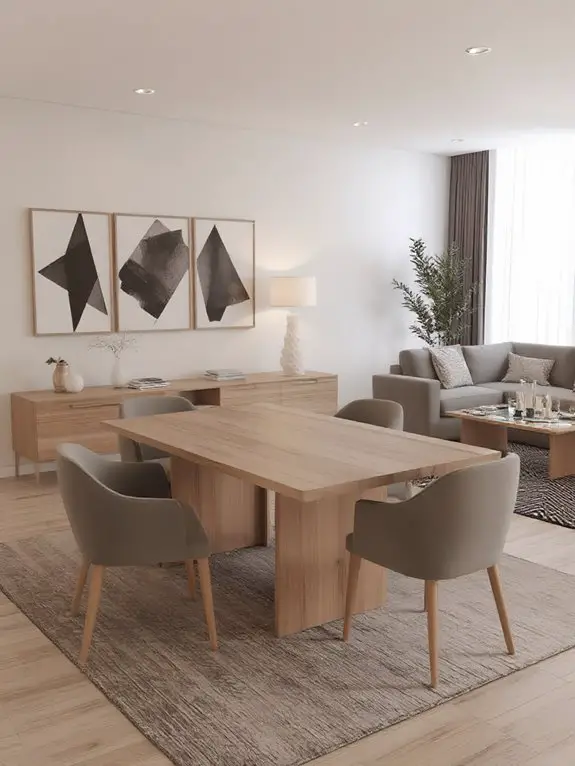
When I’m looking to maximize space without compromising on functionality, a foldable dining table becomes an essential addition to my living room. It’s perfect for smaller spaces, as it can be tucked away when not in use, freeing up valuable floor area.
I prefer models with sleek designs that blend seamlessly with my decor. Choosing one with extendable leaves allows me to accommodate more guests during gatherings.
Portable and easy to clean, it’s ideal for quick meals or even as a workspace. Pair it with lightweight chairs or stools for extra convenience, ensuring my living room remains adaptable and practical.
Install Floating Shelves for Display and Storage
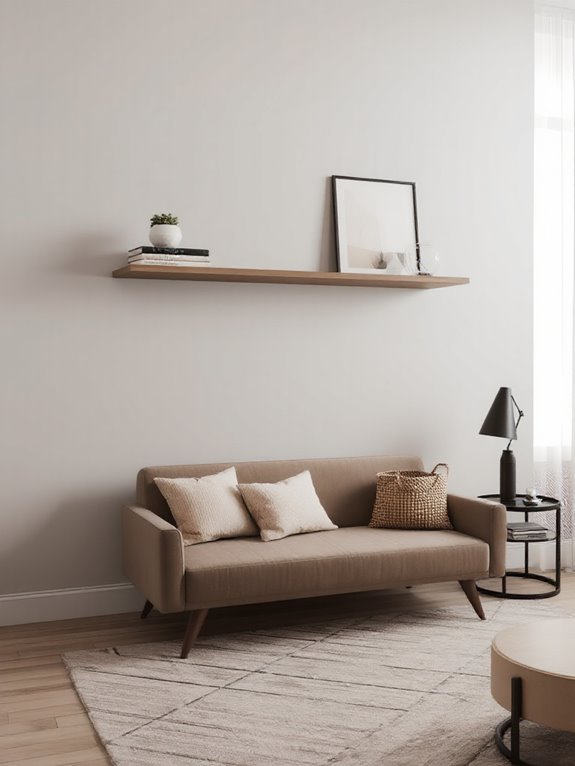
Floating shelves offer a smart solution for adding both display and storage to a living room without sacrificing floor space. I love how they keep surfaces clutter-free while showcasing books, plants, or decor that reflect my personality.
When installing them, I make certain they’re anchored securely into studs for stability, especially if I plan to display heavier items. I also experiment with varying heights and lengths to create visual interest and balance.
For a cohesive look, I match the shelf material to my existing furniture or opt for contrasting textures. They’re practical, stylish, and perfect for maximizing vertical space in smaller rooms.
Use a Room Divider to Define Spaces
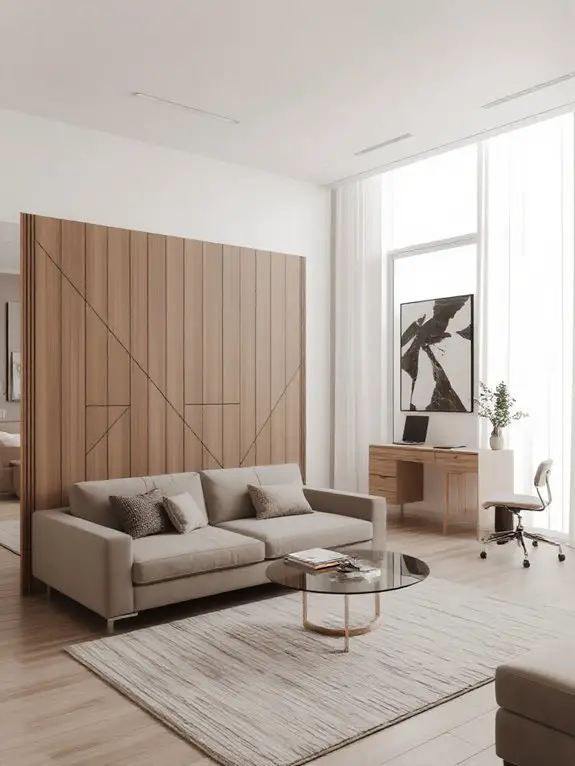
If I want to create distinct zones in my living room without permanent walls, I’ll use a room divider to define spaces effectively. A stylish bookshelf, folding screen, or even a curtain can separate areas like a reading nook from a workspace.
I’ll choose materials that complement my decor, ensuring it blends seamlessly. For added functionality, I’ll pick dividers with storage or display options.
Positioning is key—I’ll place it to maximize flow while maintaining privacy where needed. This approach not only organizes the room but also adds visual interest, making the space feel purposeful and cohesive without sacrificing openness.
Opt for Multi-Level Seating Solutions
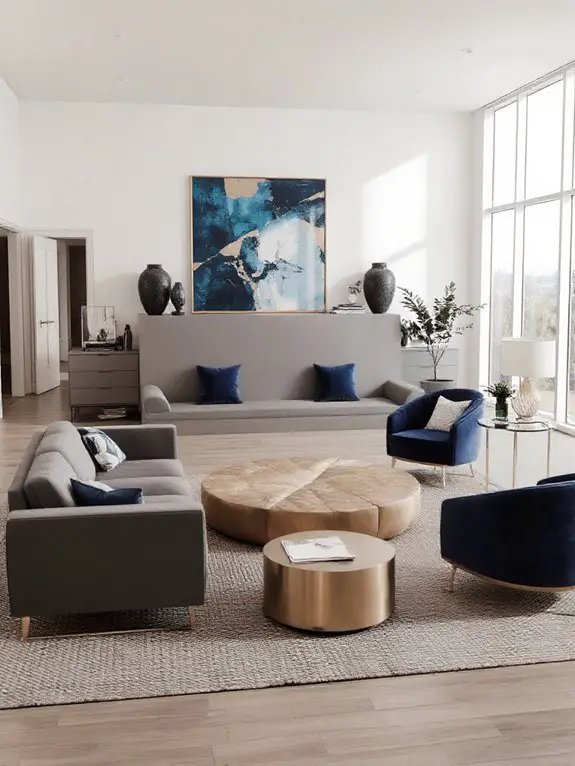
To create a dynamic and functional living room, I’ll incorporate multi-level seating solutions that cater to both style and practicality. By using a mix of sofas, armchairs, and floor cushions, I can establish distinct zones for conversation, relaxation, and activity.
Elevated seating, like bar stools or bench seating along a window ledge, adds height variation, making the space feel more layered and inviting. Ottomans or poufs can double as additional seating or footrests, offering flexibility.
I’ll also consider built-in benches or tiered platforms to maximize space efficiency. This approach guarantees the room feels cohesive yet versatile for different needs.
Incorporate a Daybed for Lounging and Sleeping
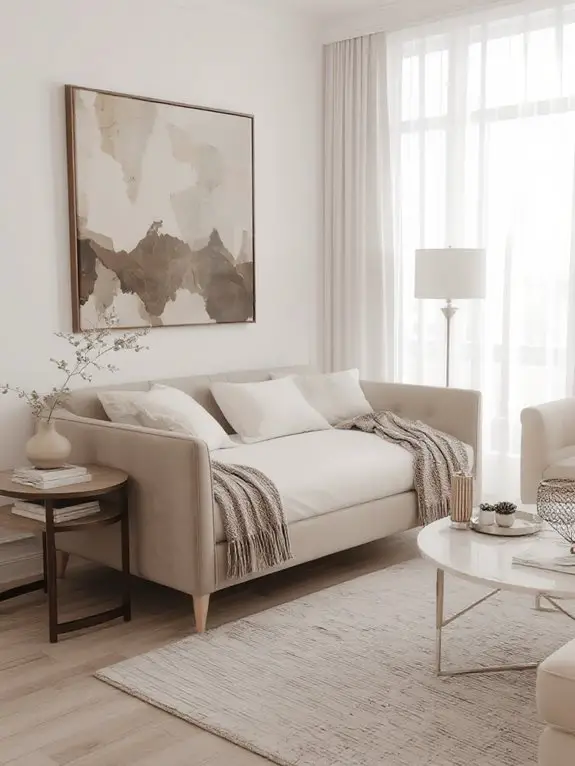
A daybed offers a stylish and practical solution for blending lounging and sleeping in a multifunctional living room. I’ve found it’s perfect for smaller spaces, as it doubles as a sofa and a bed when needed. Opt for one with a sturdy frame and comfortable cushions to guarantee it’s both functional and cozy.
Adding throw pillows and a soft blanket can make it feel inviting for daytime relaxing. I often position it near a window or in a corner to maximize space. It’s a seamless way to create flexibility without sacrificing style, making it a must-have for versatile living.
Design a Play Area With Hidden Storage
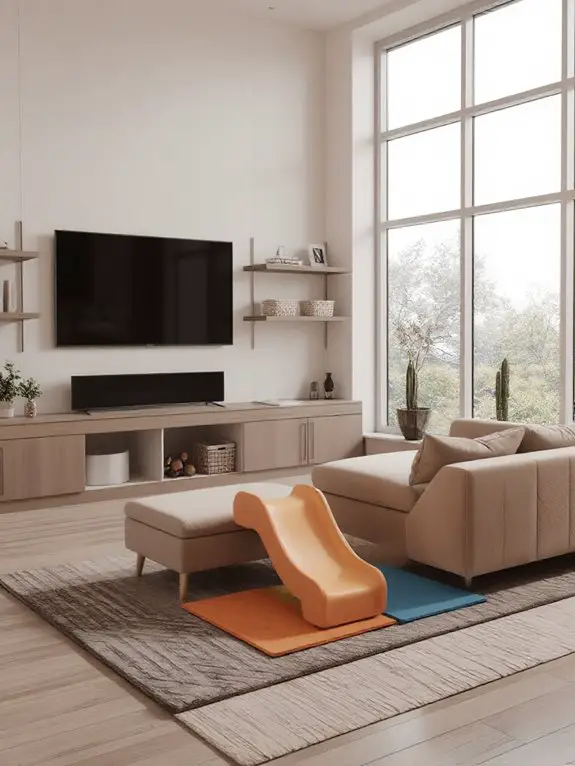
When designing a play area with hidden storage, I prioritize functionality without compromising on style. I choose benches or low cabinets with built-in compartments to stash toys and games, keeping the space tidy yet accessible.
Floating shelves with baskets or bins blend seamlessly into the decor while offering ample storage. To maximize space, I opt for multifunctional furniture like a toy chest that doubles as seating or a play table with drawers underneath.
Neutral tones or playful patterns guarantee the storage solutions complement the room’s aesthetic, creating a cohesive look that’s both practical and visually appealing.
Use Ottoman Furniture With Hidden Compartments
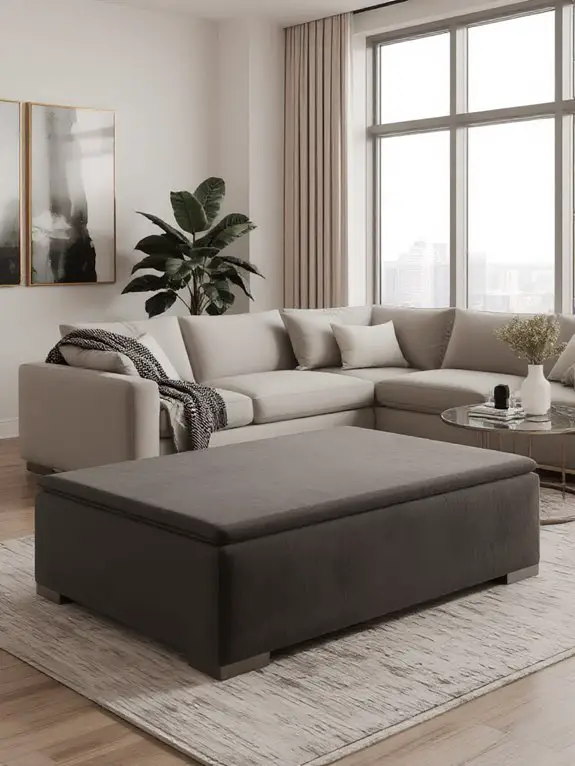
Since maximizing space is essential in any living room, I rely on ottoman furniture with hidden compartments to combine functionality with style. These versatile pieces serve as footrests, extra seating, or even coffee tables while discreetly storing blankets, magazines, or toys.
I prefer models with lift-top lids or removable cushions for easy access. Leather or sturdy fabric upholstery guarantees durability, and neutral colors blend seamlessly with any decor.
For smaller rooms, I opt for compact designs that don’t overwhelm the space. The hidden storage keeps clutter out of sight, maintaining a tidy, organized look without sacrificing comfort or aesthetic appeal.
Install a Murphy Bed for Space-Saving Sleep
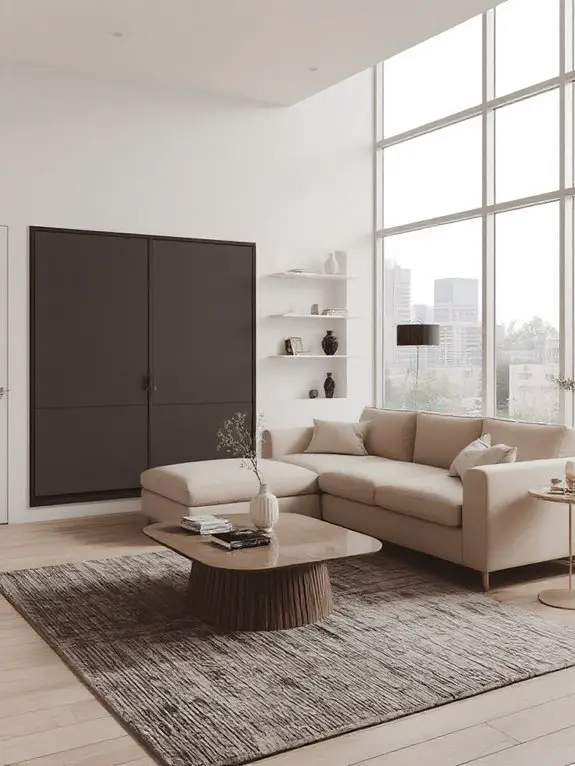
Murphy beds are an excellent solution for saving space in multifunctional living rooms, especially when hosting overnight guests or needing a temporary sleeping area. I’ve found that they’re perfect for maximizing floor space during the day, folding neatly into the wall or a cabinet when not in use.
Look for models with built-in storage for bedding or pillows to keep everything organized. When choosing one, consider the mattress quality and ease of operation—some even come with hydraulic lifts for smoother handling.
It’s a practical investment that transforms your living room into a guest room without sacrificing style or functionality.
Create a Cozy Reading Nook With Storage
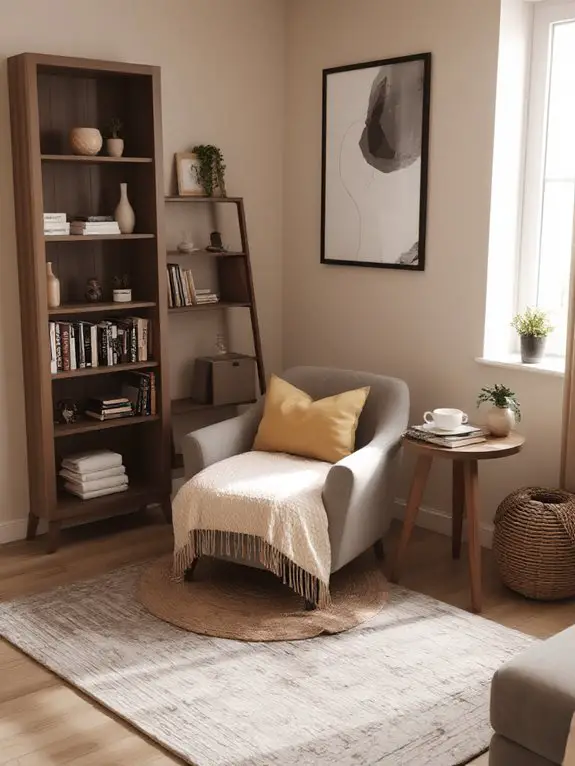
If you’re looking to carve out a quiet retreat within your living room, a cozy reading nook with added storage can be both functional and inviting. Start by selecting a corner with good natural light or adding a warm lamp for evening reading.
A comfortable armchair or chaise lounge paired with soft cushions and a throw blanket creates the perfect spot to unwind. Incorporate built-in shelves or a small side table with drawers to store books, magazines, and reading essentials.
Adding a rug and a few decorative plants can enhance the ambiance, making it a serene escape for daily reading sessions.
Add a Wall-Mounted Desk for Compact Workstations
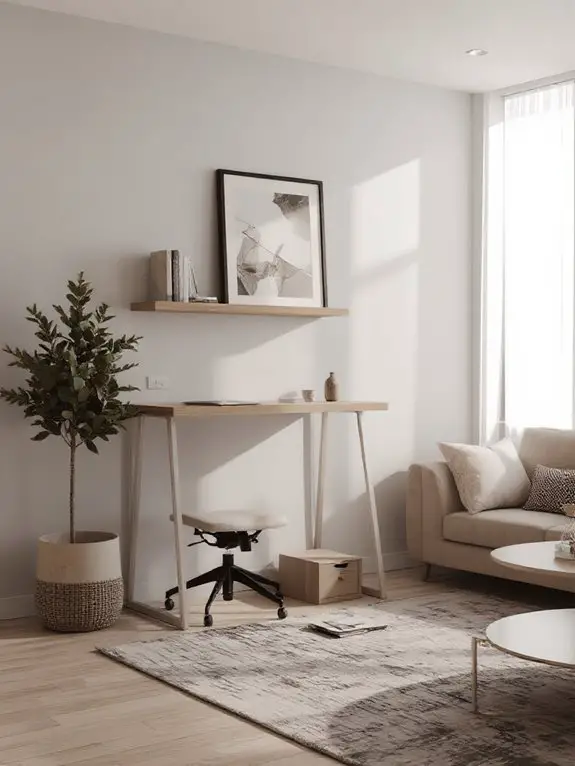
After creating a cozy reading nook, I found myself needing a dedicated space for work without sacrificing too much floor area. A wall-mounted desk became the perfect solution—it’s compact, functional, and blends seamlessly into my living room.
I chose a sleek, foldable design that tucks away when not in use, maximizing flexibility. Pairing it with a slim chair guarantees it doesn’t overcrowd the space.
I added minimal shelving above for essentials like notebooks or chargers, keeping the area tidy. This setup allows me to shift effortlessly from relaxation to productivity, proving that small spaces can still be highly functional with thoughtful design.
Use Dual-Purpose Coffee Tables
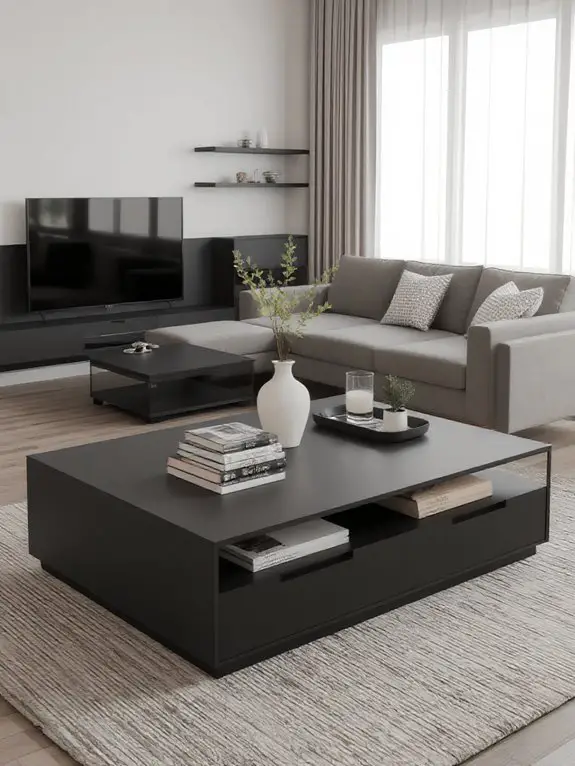
I’ve discovered that dual-purpose coffee tables are a game-changer for maximizing functionality in my living room. These tables aren’t just for holding drinks or décor—they often double as storage units or even expandable surfaces for meals or work.
I love models with built-in drawers or lift-top designs that reveal hidden compartments. Some even convert into desks or dining tables, perfect for small spaces.
Choosing a style that complements my décor while adding utility has been key. It’s a smart way to declutter and make the most of every square inch, especially in multifunctional living rooms that serve multiple needs.
Incorporate a Media Center With Concealed Storage
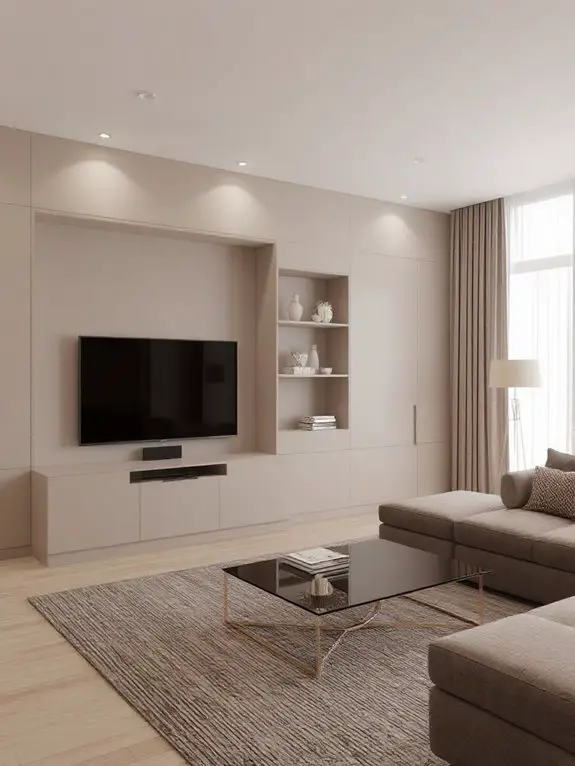
Maximizing space in a multifunctional living room often means thinking beyond the basics, like moving from dual-purpose coffee tables to a media center with concealed storage. I’ve found that a sleek console with hidden compartments keeps electronics, cords, and media out of sight, creating a cleaner aesthetic.
Opt for designs with adjustable shelves to accommodate different devices, or consider units with sliding panels or flip-down doors to disguise clutter. Built-in lighting can highlight decor while maintaining functionality.
Design a Multi-Level Ceiling for Visual Interest
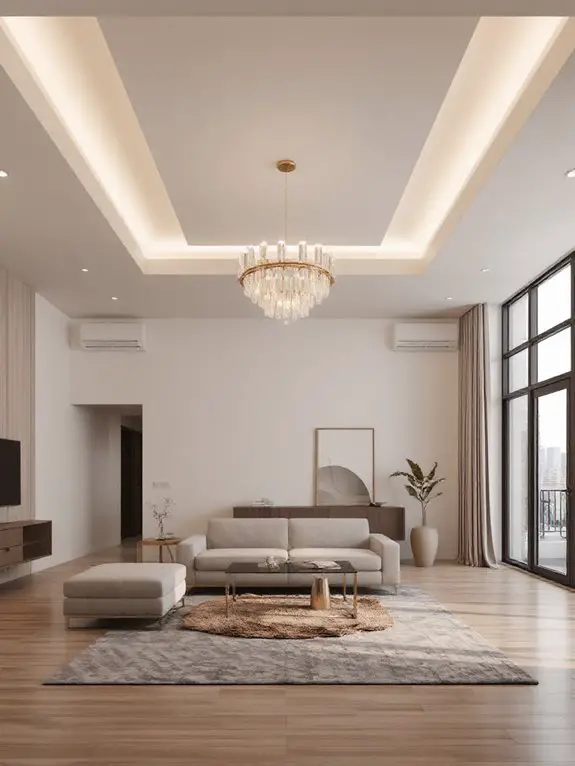
While designing a multifunctional living room, incorporating a multi-level ceiling can transform the space by adding depth and visual intrigue. I’ve found that varying ceiling heights helps define different zones without physical barriers, making the room feel larger.
For instance, a lower ceiling over a cozy seating area creates intimacy, while a higher one above the dining space adds grandeur. Consider using materials like wood beams or plaster molding to enhance texture.
Lighting plays a pivotal role—spotlights or recessed fixtures can emphasize levels effectively. A multi-level ceiling not only elevates aesthetics but also makes the room feel dynamic and thoughtfully designed.
Use Sliding Doors to Maximize Space
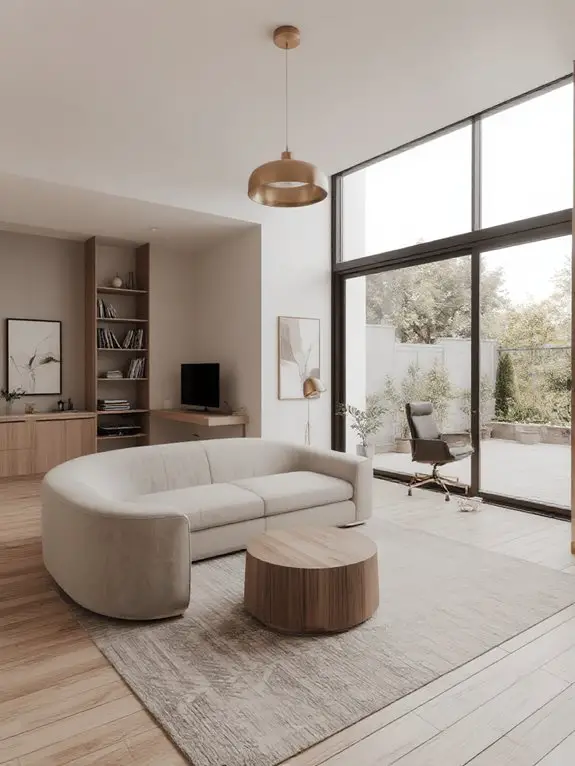
Installing sliding doors is a game-changer when it comes to maximizing space in a multifunctional living room. I’ve found they’re perfect for creating flexible zones without sacrificing floor area. Unlike traditional swinging doors, sliding doors glide along a track, freeing up valuable square footage.
Opt for glass panels to maintain an open, airy feel while separating spaces like a home office or dining area. I recommend choosing doors with frosted or textured glass for added privacy without compromising light flow.
For a seamless look, pocket sliding doors that disappear into the wall are my go-to. They’re practical, stylish, and space-efficient.
Add a Foldable Bar Cart for Entertaining
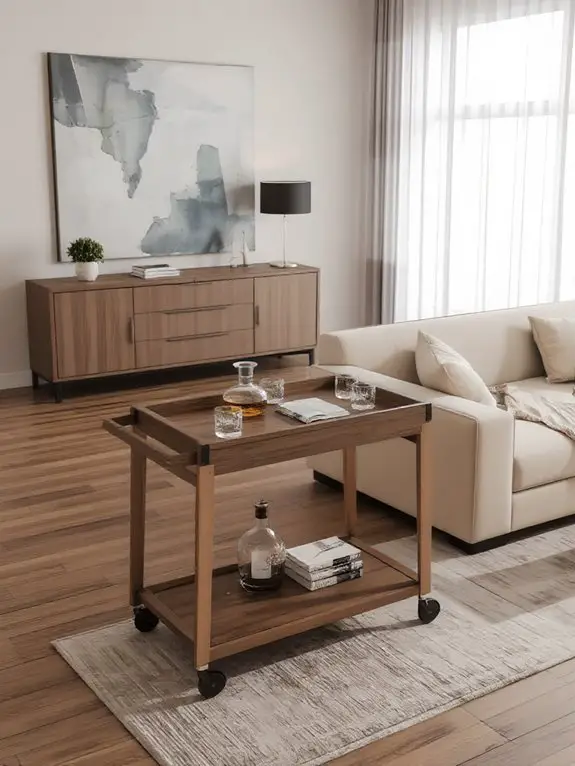
When space is limited but entertaining is a priority, a foldable bar cart can be a lifesaver. I’ve found it’s perfect for hosting small gatherings, as it stores easily when not in use. I prefer one with wheels for flexibility and shelves for organizing glasses, bottles, and snacks.
When folded, it tucks neatly into a closet or corner, freeing up floor space. Opt for a stylish design that complements your living room’s aesthetic—metallic finishes or sleek wood are versatile choices.
It’s a practical solution for keeping drinks and essentials accessible without sacrificing room for guests to mingle comfortably.
Incorporate a Pet-Friendly Zone With Built-In Features
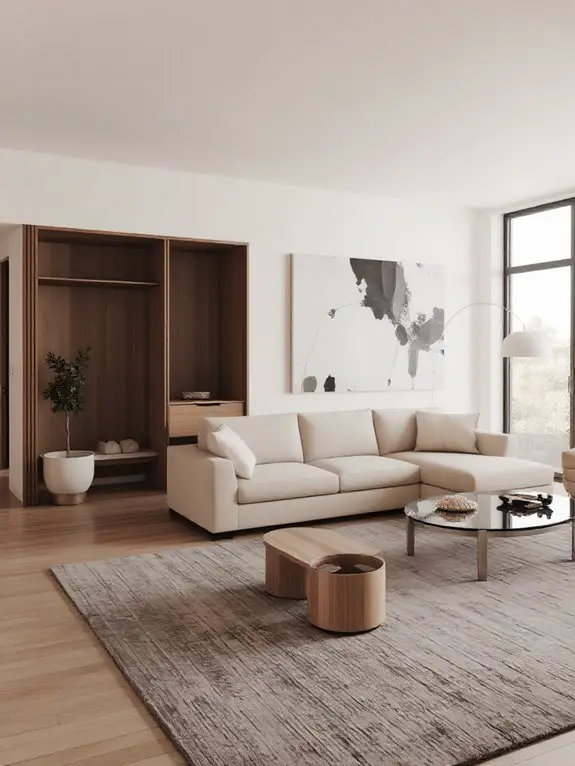
A foldable bar cart keeps the living room versatile, but for pet owners, creating a dedicated zone for furry friends can make the space even more functional. I recommend incorporating built-in features like a comfy pet bed that slots into a bench or a cubby under the TV console.
Adding a feeding station tucked into a corner cabinet keeps bowls out of sight but easily accessible. Don’t forget storage for toys, leashes, and grooming supplies—custom shelves or drawers work wonders. These thoughtful additions guarantee my pet feels at home while maintaining a clean, organized living area for everyone to enjoy.
Use Translucent Furniture for a Lightweight Feel
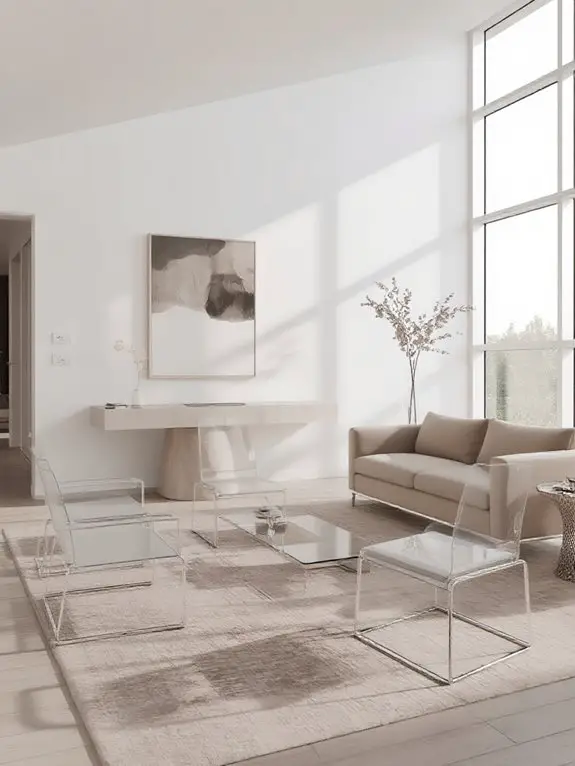
If you’re aiming to create a sense of openness in your living room, incorporating translucent furniture can make a significant difference. I’ve found that pieces like acrylic chairs, glass coffee tables, or lucite shelves allow light to pass through, making the space feel airy and less cluttered. They’re perfect for smaller rooms where every inch counts.
Translucent furniture also blends seamlessly with any decor style, whether modern or minimalist. I recommend pairing it with light-colored walls and soft textures to enhance the effect.
It’s a simple yet impactful way to elevate your living room’s ambiance while maintaining functionality.
Design a Multi-Purpose Entryway Hub
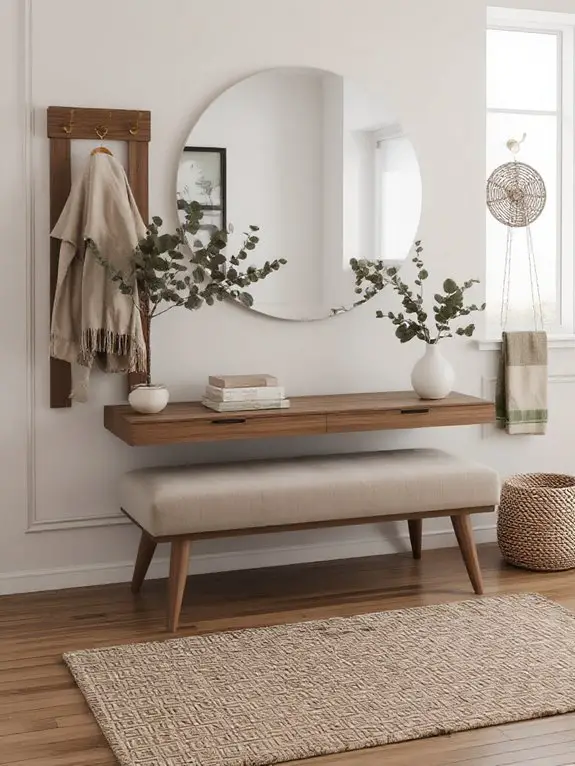
Designing a multi-purpose entryway hub can transform an intermediary space into a highly functional and organized area. I start by incorporating a bench with built-in storage for shoes, paired with hooks or a pegboard for coats, bags, and keys.
A slim console table can hold a catch-all tray for essentials like mail or sunglasses. I also add a mirror to maximize light and serve as a quick check before heading out.
For small spaces, I opt for wall-mounted shelves or foldable furniture. Using cohesive design elements and neutral tones keeps it visually appealing while maintaining practicality for daily use.
Add a Compact Exercise Area With Foldable Equipment
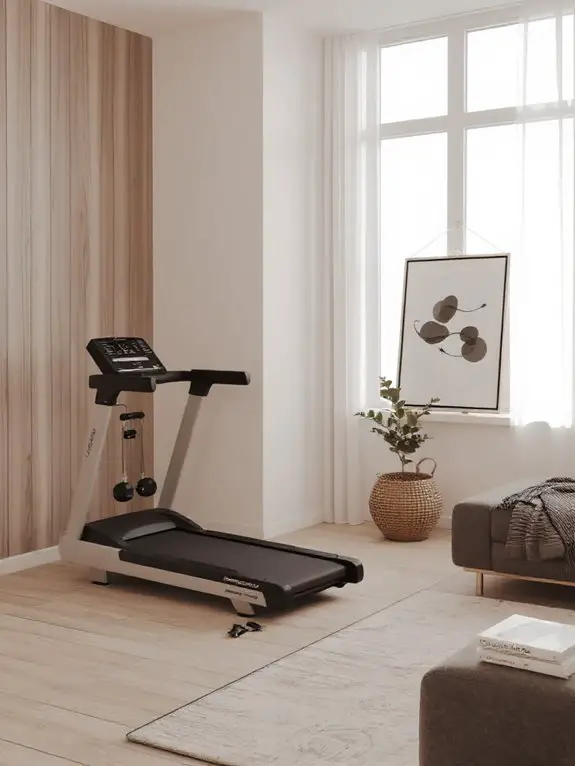
Creating a compact exercise area at home starts with prioritizing foldable, space-saving equipment to maximize functionality without sacrificing valuable square footage. I’ve found that investing in a foldable treadmill, collapsible weights, or a yoga mat that rolls up neatly is key. These pieces can easily tuck into a corner or closet when not in use.
I also recommend wall-mounted resistance bands or a pull-up bar for versatility. To keep the area organized, I use storage bins or a slim shelving unit for accessories. This setup guarantees I can stay active without compromising my living room’s aesthetic or functionality.
Use Stackable Seating for Easy Storage
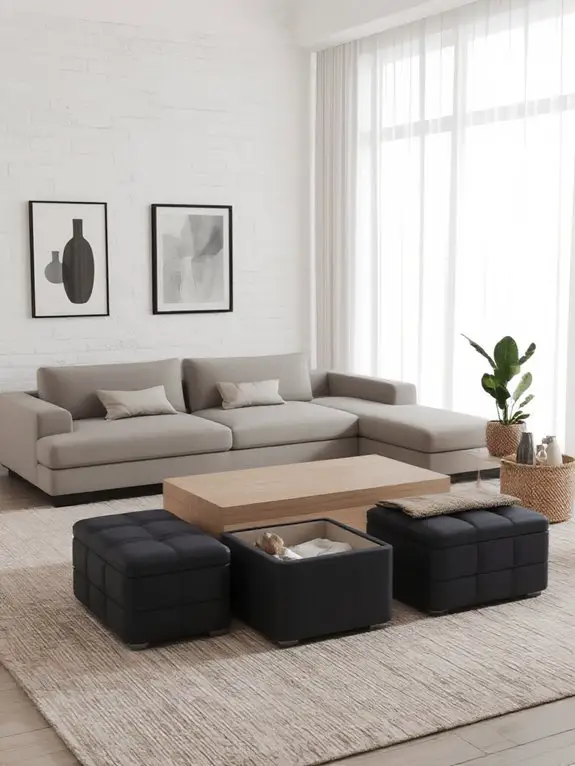
Stackable seating is a smart solution for maintaining flexibility and maximizing space in a multifunctional living room. When I need extra seating for guests but don’t want it to clutter the room during downtime, stackable chairs or stools are my go-to. They’re lightweight, easy to move, and can be neatly stored in a corner or closet when not in use.
Opt for designs that complement your decor while prioritizing practicality. I’ve found that materials like plastic, metal, or wood with a slim profile work best. This approach guarantees my living room stays adaptable without sacrificing style or comfort.
Incorporate a Vertical Garden for Greenery and Style

To add a touch of nature and visual interest to my multifunctional living room, I’ve found that a vertical garden is both practical and stylish. I installed a modular vertical garden system on an empty wall, choosing low-maintenance plants like pothos and snake plants that thrive indoors.
The greenery not only brightens the space but also improves air quality, creating a calming atmosphere. I paired it with a sleek, minimalist design to complement my decor.
For convenience, I opted for a self-watering system to reduce upkeep. It’s a subtle yet impactful way to integrate nature into my daily life without sacrificing style or function.
Frequently Asked Questions
How to Choose the Right Color Scheme for a Multifunctional Living Room?
When choosing a color scheme for my multifunctional living room, I consider the mood I want—neutral tones for calm, bright accents for energy. I test swatches in different lights to guarantee versatility across activities and times of day.
What Lighting Options Work Best for Versatile Living Spaces?
I’d go for layered lighting—overhead fixtures for general brightness, task lamps for reading or work, and dimmable LEDs to set the mood. Smart bulbs let me switch tones fast, adapting to any activity in my space.
How to Maintain a Clutter-Free Multifunctional Living Room?
I’ve read that 54% of people feel stressed by clutter in their spaces. To keep my multifunctional living room clutter-free, I prioritize hidden storage like ottomans with compartments and use vertical shelving to maximize space efficiently.
What Are Budget-Friendly Ideas for Multifunctional Designs?
I’d suggest using furniture like a sleeper sofa or ottomans with storage, repurposing items I already own, and adding modular shelves for flexibility. DIY projects and thrifted pieces also help me stay budget-friendly while maximizing space.
How to Balance Aesthetics and Functionality in a Shared Space?
Balancing aesthetics and functionality in a shared space feels like juggling art and practicality—I focus on versatile furniture with sleek designs, neutral tones for cohesion, and smart storage solutions that don’t sacrifice style for efficiency.

